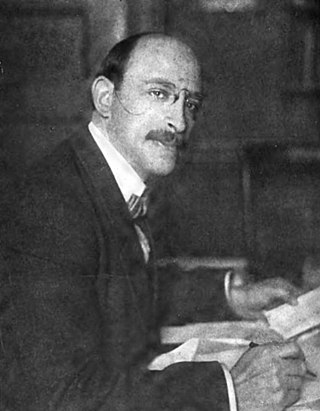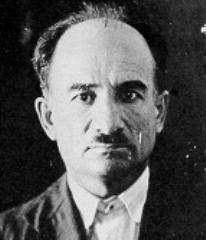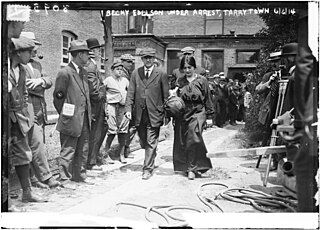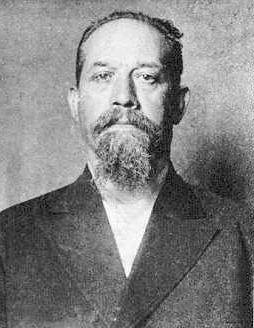The conspirators
In July 1914, two members of the Lettish section of the Anarchist Red Cross (ARC), Charles Berg and Carl Hanson, began collecting dynamite they had obtained from Russia. Plotting with them was Industrial Workers of the World (IWW) member Arthur Caron. They stored the dynamite at the apartment of another ARC member, Louise Berger, who was an editor of Emma Goldman's Mother Earth magazine. Several meetings were held at the Ferrer Center, where the group devised a plan in which Caron, Berg, and Hanson were to plant a bomb at John D. Rockefeller's home in Tarrytown, New York. [2] [3] [4]
According to later accounts, the three men, along with Alexander Berkman and Charles Robert Plunkett, met at the Ferrer Center at least twice to discuss the plot. Plunkett, a party to the conspiracy, later stated that Berkman chose to remain behind the scenes rather than take an active role in the bombing due to his being on probation for the attempted murder of Henry Clay Frick. Berkman later denied any involvement or knowledge of the plan, a denial supported by some who knew him, and rejected by others. Plunkett also claimed that neither Rockefeller nor his house were intended to be the target of the bomb, and that its detonation in Tarrytown would be merely a "gesture of protest." [2] [3]
Explosion
At 9 a.m. on July 4, Berger left her tenement building at 1626 Lexington Avenue and went to the Mother Earth offices on 119th Street. Fifteen minutes later, a deadly explosion took place on the sixth story of the Lexington Avenue building, located between 102nd and 103rd Streets in the thickly populated area of Harlem, only a few blocks away from the Ferrer Center. Passers-by witnessed a shower of debris and rubble fall into the street. The three upper floors of the tenement building were destroyed by the explosion, while debris showered rooftops and the streets below. Large pieces of furniture were thrown hundreds of feet through the air due to the power of the blast.
The bomb intended for Rockefeller had exploded prematurely inside Berger's apartment, killing Hanson, Berg, Caron and Marie Chavez, who had apparently not been involved in the conspiracy but had merely rented a room in the apartment. The blast threw Caron's body onto the mangled and twisted fire escape. The mutilated bodies of Chavez and Hanson were found inside the apartment. The blast had torn the body of Berg into pieces, which were seen by spectators being thrown through the air onto the streets. In total, twenty other people were injured, seven of them severely enough to be hospitalized. Berkman attended the men's funerals. [2] [3] Berger later denied any involvement, and police were unable to implicate her in the conspiracy. [2] [3]
Another IWW member named "Mike" Murphy was spending the night in the same apartment when the explosion occurred. The blast destroyed the floor underneath him, causing his bed to fall into the apartment below. Slightly dazed and confused, Murphy was able to walk away from the incident with only the loss of some clothes and a few minor bruises. He was immediately sought for questioning by the police but was able to slip away to Mother Earth headquarters, where it is believed that Berkman sent him into hiding, accompanied by fellow co-conspirator Plunkett. Murphy was first taken to New Jersey, then to Philadelphia by members of the Radical Library, and finally on to Canada. [2] [3]

Tarrytown is a village in the town of Greenburgh in Westchester County, New York. It is located on the eastern bank of the Hudson River, approximately 25 miles (40 km) north of Midtown Manhattan in New York City, and is served by a stop on the Metro-North Hudson Line. To the north of Tarrytown is the village of Sleepy Hollow, to the south the village of Irvington and to the east unincorporated parts of Greenburgh. The Tappan Zee Bridge crosses the Hudson at Tarrytown, carrying the New York State Thruway to South Nyack, Rockland County and points in Upstate New York. The population was 11,860 at the 2020 census.
Propaganda of the deed is specific political direct action meant to be exemplary to others and serve as a catalyst for revolution.

Alexander Berkman was a Russian-American anarchist and author. He was a leading member of the anarchist movement in the early 20th century, famous for both his political activism and his writing.

The Wall Street bombing was an act of terrorism on Wall Street at 12:01 pm on Thursday, September 16, 1920. The blast killed thirty people immediately, and another ten died later of wounds sustained in the blast. There were 143 seriously injured, and the total number of injured was in the hundreds.

August Vincent Theodore Spies was an American upholsterer, radical labor activist, and newspaper editor. An anarchist, Spies was found guilty of conspiracy to commit murder following a bomb attack on police in an event remembered as the Haymarket affair. Spies was one of four who were executed in the aftermath of this event.

The first Red Scare was a period during the early 20th-century history of the United States marked by a widespread fear of far-left movements, including Bolshevism and anarchism, due to real and imagined events; real events included the Russian 1917 October Revolution and anarchist bombings in the U.S. At its height in 1919–1920, concerns over the effects of radical political agitation in American society and the alleged spread of socialism, communism, and anarchism in the American labor movement fueled a general sense of concern.
In the United States, anarchism began in the mid-19th century and started to grow in influence as it entered the American labor movements, growing an anarcho-communist current as well as gaining notoriety for violent propaganda of the deed and campaigning for diverse social reforms in the early 20th century. By around the start of the 20th century, the heyday of individualist anarchism had passed and anarcho-communism and other social anarchist currents emerged as the dominant anarchist tendency.

The Preparedness Day Bombing was a bombing in San Francisco, California, United States, on July 22, 1916, of a parade organised by local supporters of the Preparedness Movement which advocated American entry into World War I. During the parade a suitcase bomb was detonated, killing 10 and wounding 40 in the worst terrorist attack in San Francisco's history.

John Dustin Archbold was an American businessman and one of the United States' earliest oil refiners. His small oil company was bought out by John D. Rockefeller's Standard Oil Company. Archbold rose rapidly at Standard Oil, handling many of the complex secret negotiations over the years. By 1882, he was Rockefeller's closest associate, and typically acted as the company's primary spokesman. Rockefeller, after 1896, left business matters to Archbold while he pursued his philanthropy; as vice president, Archbold effectively ran Standard Oil until his death in 1916. Inspired by Rockefeller's policies, Archbold's main goals were stabilization, efficiency, and minimizing waste in refining and distributing petroleum products. When the company was broken up by the Supreme Court in 1911 into 34 smaller operations, Archbold became president of the largest one, Standard Oil of New Jersey.

The Blast was a semi-monthly anarchist periodical published by Alexander Berkman in San Francisco, California, USA from 1916 through 1917. The publication had roots in Emma Goldman's magazine Mother Earth, having been launched when her former consort Berkman left his editorial position at that publication.

A series of bombings were carried out or attempted by Galleanists from April through June 1919. The targets included anti-immigration politicians, anti-anarchist officials, and prominent businessmen, as well as a journalist and a church. Almost all of the bombs were sent by mail. The bombings were one of the major factors contributing to the First Red Scare. Two people were killed, including one of the bombers, and two injured.

Mario Buda (1883–1963) was an Italian anarchist active among the militant American Galleanists in the late 1910s and best known for being the likely perpetrator of the 1920 Wall Street bombing, which killed 40 people and injured hundreds. Historians implicate Buda in multiple bombings, though the documentary evidence is insufficient to prove his responsibility.

Louise Berger was a Russian Latvian anarchist, a member of the Anarchist Red Cross, and editor of Emma Goldman's Mother Earth Bulletin in New York. Berger became well known outside anarchist circles in 1914 after a premature bomb explosion at her New York City apartment, which killed four persons and destroyed part of the building.

The Haymarket affair, also known as the Haymarket massacre, the Haymarket riot, the Haymarket Square riot, or the Haymarket Incident, was the aftermath of a bombing that took place at a labor demonstration on May 4, 1886, at Haymarket Square in Chicago, Illinois, United States. The rally began peacefully in support of workers striking for an eight-hour work day, the day after the events at the McCormick Harvesting Machine Company, during which one person was killed and many workers injured. An unknown person threw a dynamite bomb at the police as they acted to disperse the meeting, and the bomb blast and ensuing retaliatory gunfire by the police caused the deaths of seven police officers and at least four civilians; dozens of others were wounded.

Arthur Caron was a French Canadian anarchist and a member of the Industrial Workers of the World. He masterminded an attempt to assassinate John D. Rockefeller using a bomb constructed from dynamite. While building the device, he was killed along with Carl Hanson, and Charles Berg on July 4, 1914, when his bomb prematurely exploded. The blast also killed a renter of the building who was not part of the plot and injured dozens of others. The bomb also destroyed the building located at 1626 Lexington Avenue, New York City, New York. In the wake of Caron's death, some 5,000 mourners gathered in New York's Union Square, where anarchist leaders Alexander Berkman and Becky Edelsohn among others spoke in memory of those who died.

Rebecca Edelsohn, in contemporary sources often given as Becky Edelson, (1892–1973) was a Latvian American anarchist and hunger striker who was jailed in 1914 for disorderly conduct during an Industrial Workers of the World speech. According to The New York Times, she was the first woman to attempt a hunger strike in the United States.

Modest Stein (1871–1958), born Modest Aronstam, was a Lithuanian Jewish and American illustrator and close associate of the anarchists Alexander Berkman and Emma Goldman. He was Berkman's cousin and intended replacement in the attempted assassination of Henry Clay Frick, an industrialist and union buster, in 1892. Later Stein abandoned active anarchism and became a successful newspaper, pulp magazine, and book illustrator, while continuing to support Berkman and Goldman financially.

The Milwaukee Police Department bombing was a November 24, 1917, bomb attack that killed nine members of local law enforcement and a civilian in Milwaukee, Wisconsin, United States. The perpetrators were never caught but are suspected to be an anarchist terrorist cell operating in the United States in the early 20th century. The target was initially an evangelical church in the Third Ward and only killed the police officers when the bomb was taken to the police station by a concerned civilian. The bombing remained the most fatal single event in national law enforcement history for over 80 years until the September 11 attacks.
The Bresci Circle was a group of New York City anarchists remembered for a failed bombing attempt on St. Patrick's Cathedral in 1915, in which two of its members were arrested. The group was named after Gaetano Bresci, a New York anarchist who killed King Umberto I of Italy.

Galleanisti are followers or supporters of the insurrectionary anarchist Luigi Galleani, who operated most notably in the United States following his immigration to the country. The vast majority of Galleanisti or Galleanists were similarly poor and working class Italian immigrants or Italian Americans, and especially Italian anarchists and Italian immigrants or Italian-Americans involved in the labor movement of the time. Galleanists remain the primary suspects in a campaign of bombings between 1914 and 1920 in the United States.




















